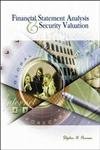Items related to Financial Statement Analysis and Security Valuation...
Financial Statement Analysis and Security Valuation (Mcgraw-Hill International Editions: Finance Series) - Softcover

Synopsis
This volume explores financial statement analysis and security valuation. Topics include investment returns, valuation models, and the financial statements, forecasting dividends and cash flows, accounting measurement and valuation from earnings forecasts and an accrual accounting valuation model.
"synopsis" may belong to another edition of this title.
From the Publisher
Focus on the output of financial statements, not the input (user focus vs. preparer). A number of financial statement analysis texts have chapters that explain how the accounting is done, many with material similar to that in intermediate accounting texts. This text asks what the financial statements tell you, not how they are prepared. However, the user of financial statements has to have some knowledge of accounting. Part 4 of the text covers many accounting details, but in a way that examines accounting methods from the point of view of how they help or hinder analysis. This way, students develop a critical perspective on the accounting to supplement the descriptive one acquired in accounting courses.
The text brings finance and accounting concepts together. In a typical program, students get their accounting "here" and their finance "there." Finance professors often do not cover how accrual accounting helps in valuation and settle for cash-flow analysis. Accounting professors teach accrual accounting and financial statement (ratio) analysis, but sometimes don't make the link to investment questions. This book links accounting and finance so that the financial statement analysis is guided by concepts of finance and central issues in finance equity and debt valuation within an accounting framework.
Penman takes a disciplinary approach to the subject. That is, it builds the analysis from "first principles" in a systematic way so students can see where things are coming from. The author believes that in the area of investments, where there are many suspect techniques, the student needs to have the confidence that the analysis is rigorous and sound. An alternative approach is to teach by metaphor through cases without a formal framework. Cases are included as applications of the analysis, but the book is, in the real sense, a textbook.
The text takes an activist approach to investing (and using financial statements for investing.) It does not assume that the market is efficient. It encourages students to think that a stock might be mispriced, so it gives students a motivation to be active about doing analysis. This in no way prejudges the market efficiency issue. It is a pedagogical device and the student might well discover, through analysis, that a particular stock's price is efficient.
This text shows how to move from concepts to practice. It is "product" oriented in that it aims to show how to build a concrete valuation technology based on the financial statements. Most of the analysis can be built into a spreadsheet program.
This text is "state of the art." It reflects recent developments in research and practice, particularly the use of residual-income (economic profit) techniques. Author Stephen Penman is among the top financial accounting academics in the world. He is extremely well known for his research, which is the framework of this textbook.
Penman incorporates cases, problems, and exercises from real world companies including Wal-Mart and Hewlett-Packard. The real world emphasis is a major strength of the text.The web site will have links to data sources and the financial press, including Standard & Poors (COMPUSTAT) data and Business Week sites, as well as relevant public sites. It will also include additional material and examples and a number of devices to help instructors deliver the course efficiently.
About the Author
Stephen Penman is the L.H. Penney Professor of Accounting at the University of California at Berkeley. He received his Ph.D. from the University of Chicago in 1978. He has published extensively in the Journal of Accounting and Economics, the Journal of Accounting Research, and the Contemporary Accounting Research journal. he currently on the editorial board of the Review of Accounting Studies. He is known around the world for his reserch in Financial Accounting.
"About this title" may belong to another edition of this title.
£ 2.81 shipping within U.S.A.
Destination, rates & speedsSearch results for Financial Statement Analysis and Security Valuation...
Financial Statement Analysis and Security Valuation
Seller: HPB-Red, Dallas, TX, U.S.A.
paperback. Condition: Good. Connecting readers with great books since 1972! Used textbooks may not include companion materials such as access codes, etc. May have some wear or writing/highlighting. We ship orders daily and Customer Service is our top priority! Seller Inventory # S_359219130
Quantity: 1 available
Financial Statement Analysis and Security Valuation
Seller: Goodwill of Silicon Valley, SAN JOSE, CA, U.S.A.
Condition: good. Supports Goodwill of Silicon Valley job training programs. The cover and pages are in Good condition! Any other included accessories are also in Good condition showing use. Use can include some highlighting and writing, page and cover creases as well as other types visible wear. Seller Inventory # GWSVV.0071181296.G
Quantity: 1 available
Financial Statement Analysis and Security Valuation (Mcgraw-Hill International Editions: Finance Series)
Seller: WorldofBooks, Goring-By-Sea, WS, United Kingdom
Paperback. Condition: Fair. A readable copy of the book which may include some defects such as highlighting and notes. Cover and pages may be creased and show discolouration. Seller Inventory # GOR006362714
Quantity: 1 available
Financial Statement Analysis and Security Valuation (Mcgraw-Hill International Editions: Finance Series)
Seller: WeBuyBooks, Rossendale, LANCS, United Kingdom
Condition: Very Good. Most items will be dispatched the same or the next working day. A copy that has been read, but is in excellent condition. Pages are intact and not marred by notes or highlighting. The spine remains undamaged. Seller Inventory # wbs4754361575
Quantity: 1 available
